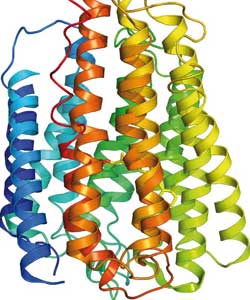Optogenetic tool elucidated: RUB researchers explain channelrhodopsin

The Bochum homology model predicts the structure of a channelrhodopsin so well that it has been even possible to make statements about its function. The illustration shows the prediction in comparison to the later crystal structure<br>
Controlling nerve cells with the aid of light: this is made possible by optogenetics. It enables, for example, the investigation of neurobiological processes with unprecedented spatial and temporal precision. The key tool of optogenetics is the light-activated protein channelrhodopsin. Biophysicists from Bochum and Berlin have now succeeded in explaining the switching mechanism through an interdisciplinary approach. The researchers report on their findings in the “Journal of Biological Chemistry”.
Redistribution of water molecules
Until now, little has been known about the mechanism of the protein – especially about how the channel opens. However, deeper understanding is a prerequisite in order to be able to use the light-controlled protein specifically for neurobiological applications. In a new, multi-disciplinary approach, the Bochum scientists led by Prof. Dr. Klaus Gerwert (Department of Biophysics at the RUB) and their cooperation partners in Berlin have been able to shed light on the switching mechanism. The result: the light-induced change in the charge state of amino acid glutamate 90 (E90) triggers an increased penetration of water molecules, so that the protein can now purposefully conduct ions through the cell membrane.
Three methods combined
Using time-resolved infrared spectroscopy, the RUB biophysicists Jens Kuhne and Dr. Erik Freier have been able to show for the first time that the channel is opened through the deprotonation of the amino acid glutamate 90 (E90). In addition, the electrophysiological experiments of the researchers in Berlin confirm that a mutation of the amino acid leads to a change in the ion permeability of the protein. Instead of using safety goggles and lab coats, the two biophysicists Kirstin Eisenhauer and Dr. Steffen Wolf at the Department of Biophysics used supercomputers to simulate how the protonation change of the glutamate opens the channel and allows water molecules to penetrate.
Internationally preeminent
The work has attained particular distinction right now, because shortly after the Bochum pre-publication on the Internet, Japanese researchers published the three-dimensional structure of a channelrhodopsin online in “Nature”. “The structure work impressively confirms our biomolecular simulations and the key role played by the amino acid E90 in the switching of the channel”, says Prof. Klaus Gerwert. “We are therefore particularly proud to have been preeminent in this internationally competitive field.” In 2010, optogenetics was distinguished by “Nature Methods” as the “Method of the Year”. Using this method, researchers have succeeded, for example, in restoring the eyesight of blind mice.
Bibliographic record
K. Eisenhauer, J. Kuhne, E. Ritter, A. Berndt, S. Wolf, E. Freier, F. Bartl, P. Hegemann, K. Gerwert,: In channelrhodopsin-2 E90 is crucial for ion selectivity and is deprotonated during the photocycle, The Journal of Biological Chemistry, Vol. 287, Issue 9, 6904-6911, 2012, DOI: 10.1074/jbc.M111.327700
Further information
Prof. Dr. Klaus Gerwert, Department of Biophysics, Faculty of Biology and Biotechnology at the Ruhr-Universität Bochum, Tel. +49 234 32 24461, gerwert@bph.rub.de
Editor: Jens Wylkop
Media Contact
More Information:
http://www.ruhr-uni-bochum.deAll latest news from the category: Life Sciences and Chemistry
Articles and reports from the Life Sciences and chemistry area deal with applied and basic research into modern biology, chemistry and human medicine.
Valuable information can be found on a range of life sciences fields including bacteriology, biochemistry, bionics, bioinformatics, biophysics, biotechnology, genetics, geobotany, human biology, marine biology, microbiology, molecular biology, cellular biology, zoology, bioinorganic chemistry, microchemistry and environmental chemistry.
Newest articles

A universal framework for spatial biology
SpatialData is a freely accessible tool to unify and integrate data from different omics technologies accounting for spatial information, which can provide holistic insights into health and disease. Biological processes…

How complex biological processes arise
A $20 million grant from the U.S. National Science Foundation (NSF) will support the establishment and operation of the National Synthesis Center for Emergence in the Molecular and Cellular Sciences (NCEMS) at…

Airborne single-photon lidar system achieves high-resolution 3D imaging
Compact, low-power system opens doors for photon-efficient drone and satellite-based environmental monitoring and mapping. Researchers have developed a compact and lightweight single-photon airborne lidar system that can acquire high-resolution 3D…





















